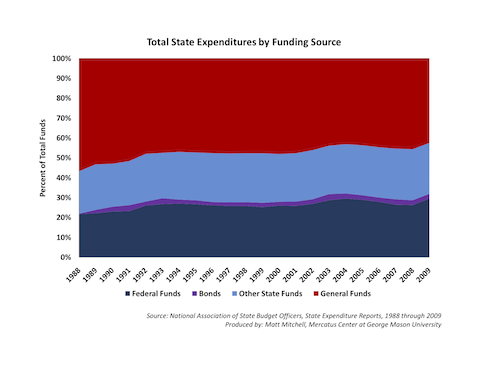- | Government Spending Government Spending
- | Data Visualizations Data Visualizations
- |
Total State Expenditures by Funding Source
As this chart by Mercatus Research Fellow Matthew Mitchell demonstrates, over time, states have increasingly come to rely less on general fund sources and more on federal sources, dedicated sources, and borrowed sources.
The money that a state spends can come from four broad categories:
1. The state’s general fund, which comes from tax revenue that is not earmarked for a particular purpose but can go to any program from education to Medicaid;
2. Other state funds, which come from tax and fee revenue that is dedicated to particular purposes such as highways or Medicaid;
3. Federal funds, almost all of which must be spent on designated projects; and
4. Bonds, which must usually be spent on capital projects.
As this chart by Mercatus Research Fellow Matthew Mitchell demonstrates, over time, states have increasingly come to rely less on general fund sources and more on federal sources, other state funds, and borrowed sources. For the most part, funds from the latter three categories are “earmarked” to particular, or dedicated, purposes.
In 1988, general funds were the source of 56.7% of all state spending and dedicated funds were the source of the remaining 43.2%. By 2009, these shares had flipped so that general funds were the source of just 42.5% of all funding while dedicated sources were the source of 57.5%.
This is akin to the way federal funding is increasingly dominated by “non-discretionary” spending, over which lawmakers claim to have little responsibility. Read Mitchell’s working paper on State Spending Restraint to learn about the ways state spending has changed over time.


